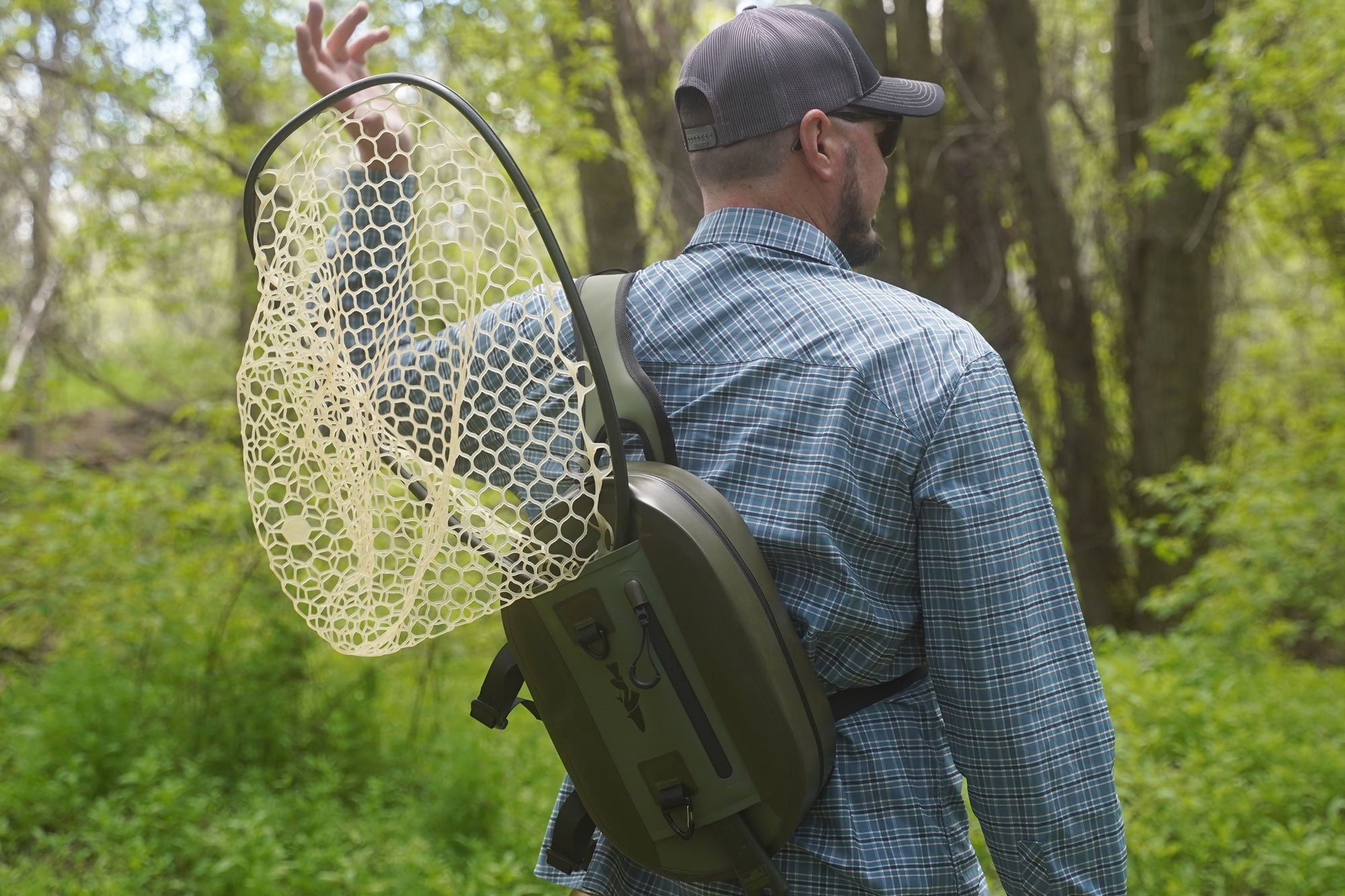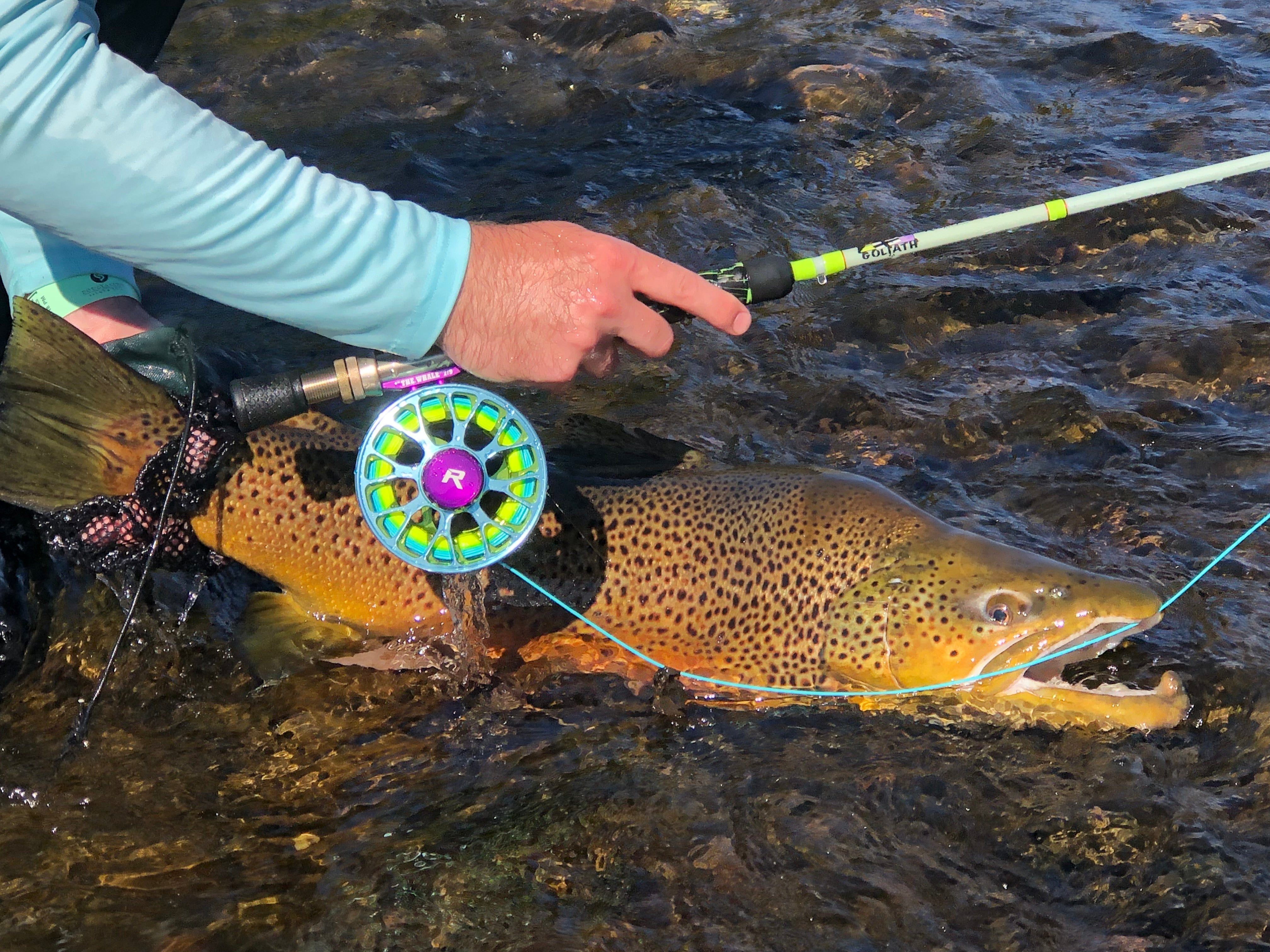Master the most challenging aspect of dry fly fishing by learning to fish emerger patterns that consistently fool even the most selective and educated trout
The Secret Stage That Changes Everything
Emerger fishing represents the pinnacle of advanced dry fly fishing, targeting the most vulnerable stage of an insect's life cycle when trout are most likely to feed selectively. During emergence, insects are trapped in the surface film, making them easy targets for large, cautious trout that often refuse traditional dry flies. Master emerger fishing, and you'll unlock success with the most challenging fish in the most technical situations.
This comprehensive guide covers everything from understanding emergence behavior to mastering the subtle presentations that make emerger fishing the ultimate test of dry fly fishing skills. When traditional dry flies fail and fish are rising steadily but refusing your offerings, emerger patterns and techniques often provide the solution.
WATCH: Emerger fishing techniques
Understanding Emergence: The Science Behind Success
What Makes Emergers Special
The Emergence Process:
- Trigger Phase: Nymphs/pupae respond to environmental cues
- Ascent Stage: Movement from bottom to surface
- Film Stage: Critical vulnerability at surface interface
- Transformation: Emergence from nymphal to adult form
- Escape Phase: Breaking free from surface tension
Why Trout Prefer Emergers:
- Vulnerability: Insects trapped and unable to escape
- Energy Efficiency: Easy meals requiring minimal effort
- Concentration: Multiple insects in small area
- Predictability: Repeated behavior patterns
- Size: Often larger than adult insects due to trapped gases
Mayfly vs. Caddisfly Emergence
Mayfly Emergence Characteristics:
- Direct Transformation: Nymph to dun on surface
- Surface Film Dependence: Must break through surface tension
- Extended Vulnerability: Longer time in vulnerable position
- Seasonal Timing: Species-specific emergence schedules
- Weather Sensitivity: Barometric pressure affects timing
Caddisfly Emergence Patterns:
- Pupal Stage: Intermediate pupal stage before adult
- Swimming Ability: Better equipped for surface ascent
- Gas Bubble Aid: Trapped gases assist in rising
- Quick Emergence: Faster transformation to flying adult
- Evening Activity: Many species emerge at dusk
Midge Emergence Behavior:
- Continuous Activity: Emerges throughout season
- Small Size: Tiny but incredibly numerous
- Film Suspension: Hangs in surface film extensively
- Weather Independence: Less affected by conditions
- Concentration: Massive numbers create feeding opportunities
Essential Emerger Patterns for Dry Fly Fishing
Classic Emerger Designs
Sparkle Dun:
- Innovation: Gary LaFontaine's revolutionary design
- Materials: Z-lon shuck, sparse hackle, dubbed body
- Function: Suggests insect emerging from shuck
- Effectiveness: Proven pattern for selective fish
- Variations: Available for all major insect species
CDC Emerger:
- Material: Cul de Canard for natural flotation
- Action: Natural movement in surface film
- Buoyancy: Sits perfectly in surface tension
- Visibility: Low profile challenges angler
- Selectivity: Excellent for educated trout
Quigley Cripple:
- Design: Vertical orientation in water
- Visibility: Post for angler reference
- Profile: Realistic trapped insect appearance
- Effectiveness: Extremely productive pattern
- Versatility: Works for various insect types
RS2 (Rim's Semblance 2):
- Simplicity: Minimal materials, maximum effectiveness
- Profile: Perfect emerger silhouette
- Size Range: #16-24 for various situations
- Color Options: Match specific insect emergences
- Proven: Tournament and guide-tested pattern
Specialized Emerger Variations
Barr Emerger:
- Innovation: John Barr's technical pattern
- Materials: Modern synthetics for durability
- Action: Lifelike movement in surface film
- Effectiveness: Consistently produces on tough fish
- Applications: Technical waters and educated trout
Film Critic:
- Design: Sits perfectly in surface film
- Materials: Foam and natural fibers
- Visibility: Easy for angler to track
- Effectiveness: Works when others fail
- Conditions: Excellent in flat water
Jujubee Midge:
- Target: Midge emergence situations
- Size: Tiny patterns for selective feeding
- Profile: Perfect midge emerger silhouette
- Challenge: Requires precise presentation
- Results: Incredibly effective on technical waters
WATCH: Identify emergers for fly fishing
Advanced Emerger Presentation Techniques
Reading Emerger Rises
Identifying Emerger Feeding:
- Rise Form: Subtle dimples rather than splashy rises
- Timing: Consistent, rhythmic feeding patterns
- Location: Feeding lanes and current seams
- Refusals: Fish refusing traditional dry flies
- Visibility: Insects visible in surface film
Rise Form Analysis:
- Dimple Rise: Small disturbance, fish taking just below surface
- Head-and-Tail Rise: Both head and tail visible, classic emerger take
- Porpoise Rise: Rolling motion, fish taking subsurface
- Sip Rise: Barely visible disturbance
- Refusal Rise: Fish approaching but not taking
The Dead Drift Emerger
Perfect Dead Drift Technique:
- Line Management: Eliminate all drag from presentation
- Current Reading: Understand complex current patterns
- Mending: Correct line position throughout drift
- Duration: Allow extended drift through feeding zone
- Patience: Give fish time to inspect and take
Micro-Drag Elimination:
- Leader Design: Long, fine leaders for natural presentation
- Casting Angle: Position for optimal drift
- Line Control: Manage floating line for drag-free drift
- Tippet Selection: Light tippet for natural fly behavior
- Environmental Factors: Account for wind and surface conditions
Advanced Emerger Retrieves
Induced Take Technique:
- Subtle Movement: Barely perceptible fly animation
- Timing: Movement just as fish approaches
- Method: Slight twitch or lift of rod tip
- Theory: Suggests insect struggling to emerge
- Effectiveness: Often triggers immediate strike
Swing Emerger Method:
- Downstream Cast: Allow emerger to swing naturally
- Controlled Speed: Manage swing speed with line control
- Depth Variation: Fish various depths during swing
- Strike Detection: Be ready for takes throughout swing
- Follow-Through: Maintain connection after strike
Static Film Fishing:
- No Movement: Allow emerger to sit motionless
- Surface Tension: Let pattern rest in film naturally
- Patience: Extended periods without movement
- Strike Timing: Fish may take after long observation
- Concentration: Maintain focus during static periods
Equipment for Advanced Emerger Fishing
Rod Selection for Precision
Optimal Rod Characteristics:
- Length: 8'6" to 9'6" for most situations
- Weight: 3-5 weight for delicate presentations
- Action: Medium to medium-fast for accuracy and feel
- Sensitivity: Detect subtle takes in surface film
- Quality: Consistent performance for technical fishing
Specialized Applications:
- Small Streams: Shorter rods (7'6"-8'6") for tight quarters
- Large Rivers: Longer rods (9'6"-10') for line control
- Technical Waters: Premium rods for ultimate sensitivity
- Windy Conditions: Faster action for wind penetration
Line and Leader Systems
Floating Line Requirements:
- Taper: Long front taper for delicate presentation
- Coating: High-quality coating for smooth casts
- Color: Pale colors less visible to fish
- Maintenance: Clean lines for optimal performance
Advanced Leader Construction:
- Length: 12-16 feet for most emerger fishing
- Taper: Gradual taper for energy transfer
- Tippet: 5X-7X depending on conditions
- Material: High-quality fluorocarbon for invisibility
Micro-Leader Systems:
- Ultra-Light: 6X-8X tippet for tiny patterns
- Length: Extended tippet sections for natural drift
- Knots: Perfected knot tying for reliable connections
- Backup: Multiple leaders for various conditions
WATCH: Emerger Stillwater Technique
Timing and Location for Emerger Success
Seasonal Emergence Patterns
Spring Emergence Calendar:
- Early Season: Midges and early mayflies
- Water Temperature: 45-55°F triggers first emergences
- Weather Dependence: Stable weather promotes activity
- Location: Protected areas and thermal refugia
- Timing: Midday when water is warmest
Summer Peak Activity:
- Multiple Species: Various insects emerging simultaneously
- Daily Timing: Early morning and evening peaks
- Weather Patterns: Overcast days extend activity
- Location: Feeding lanes and current seams
- Complexity: Multiple emergence stages occurring
Fall Finale Opportunities:
- Final Emergences: Last chances before winter
- Extended Periods: Longer emergence windows
- Large Insects: Bigger patterns often effective
- Predictable: More consistent timing patterns
- Trophy Potential: Large fish feeding heavily
Water Type Considerations
Spring Creek Emerger Fishing:
- Consistent Conditions: Stable flows and temperatures
- Technical Challenge: Educated, selective fish
- Pattern Requirements: Perfect imitation necessary
- Presentation: Flawless drift essential
- Equipment: Premium tackle for demanding conditions
Freestone Stream Applications:
- Variable Conditions: Changing flows and temperatures
- Opportunistic Fish: Less selective feeding behavior
- Pattern Flexibility: Broader pattern selection works
- Presentation: Some drift imperfection acceptable
- Timing: Weather-dependent emergence patterns
Tailwater Tactics:
- Consistent Flows: Predictable water levels
- Technical Fish: Highly educated trout populations
- Small Patterns: Often tiny flies required
- Precise Timing: Specific emergence schedules
- Equipment: Match tackle to demanding conditions
Multi-Fly Emerger Systems
Dry-Dropper with Emergers
Classic Setup:
- Dry Fly: Visible attractor on surface
- Emerger: Subsurface pattern below
- Spacing: 12-24 inches between flies
- Tippet: Appropriate strength for both patterns
- Advantages: Covers multiple feeding levels
Advanced Variations:
- Double Emerger: Two emerger patterns at different depths
- Mixed Species: Different insect imitations
- Size Progression: Varied sizes for selectivity
- Color Options: Multiple color choices for fish
- Seasonal Adaptation: Adjust combinations for conditions
Emerger-Nymph Combinations
Deep to Shallow Coverage:
- Nymph: Weighted pattern for depth
- Emerger: Film pattern for surface feeding
- Progression: Covers emergence from bottom to top
- Effectiveness: Maximizes feeding zone coverage
- Complexity: Requires advanced presentation skills
Strike Detection:
- Visual Cues: Watch both flies for takes
- Feel: Develop sensitivity for subsurface strikes
- Line Movement: Monitor for any unnatural behavior
- Quick Response: Immediate hook set essential
- Experience: Recognition improves with practice
Troubleshooting Emerger Problems
When Emergers Don't Work
Pattern Issues:
- Wrong Stage: May be imitating incorrect emergence phase
- Size Mismatch: Pattern too large or small for natural
- Color Problems: Doesn't match natural insect colors
- Profile Issues: Incorrect silhouette for conditions
Presentation Problems:
- Drag: Micro-drag affecting natural behavior
- Depth: Fishing wrong level in water column
- Speed: Incorrect presentation speed
- Timing: Presenting at wrong time during emergence
Environmental Factors:
- Light Conditions: Bright light may require stealth
- Water Level: Changes affect fish behavior
- Temperature: Cold water slows emergence activity
- Pressure: Atmospheric pressure affects insect activity
Advanced Problem Solving
Refusal Solutions:
- Size Down: Try smaller patterns
- Pattern Change: Switch to different emerger style
- Presentation Modification: Alter drift or retrieve
- Location Change: Move to different feeding area
Technical Adjustments:
- Leader Length: Extend for more natural presentation
- Tippet Diameter: Use lighter tippet for better action
- Fly Selection: Match exact stage of emergence
- Timing: Adjust to peak emergence periods
WATCH: Emerger fly fishing tip
Emerger Fishing for Specific Species
Mayfly Emerger Strategies
Blue Wing Olive Emergences:
- Timing: Spring and fall activity peaks
- Patterns: Size 16-20 BWO emergers
- Conditions: Overcast, cool weather
- Presentation: Dead drift in feeding lanes
- Locations: Slower water and current edges
Pale Morning Dun Tactics:
- Season: Late spring through summer
- Patterns: Size 16-18 PMD emergers
- Timing: Morning emergence periods
- Water: Focus on riffles and runs
- Fish Behavior: Often very selective feeding
Green Drake Opportunities:
- Spectacle: Major emergence events
- Patterns: Large emerger patterns (#10-12)
- Duration: Brief but intense activity
- Locations: Specific waters and timing
- Results: Trophy fish opportunities
Caddisfly Emerger Fishing
Evening Emergences:
- Timing: Late afternoon through dusk
- Activity: Multiple species emerging
- Patterns: Various caddis emerger designs
- Presentation: Both dead drift and swing
- Excitement: Often explosive feeding activity
Traveling Sedge Events:
- Behavior: Large caddis swimming to shore
- Patterns: Large, mobile emerger patterns
- Presentation: Active retrieve toward shore
- Timing: Late evening into night
- Results: Large fish in shallow water
Midge Emerger Techniques
Year-Round Opportunities:
- Consistency: Available throughout season
- Patterns: Tiny emerger patterns (#18-24)
- Challenge: Requires precision and patience
- Locations: Spring creeks and tailwaters
- Technique: Delicate presentations essential
Winter Midge Fishing:
- Opportunity: Often only emergence activity
- Patterns: Simple, small emerger designs
- Timing: Warmest parts of winter days
- Locations: Spring-fed waters
- Equipment: Light tackle for delicate presentations
Advanced Emerger Strategies
Competition Techniques
Tournament Applications:
- Efficiency: Quick pattern identification
- Precision: Accurate casts under pressure
- Adaptability: Rapid technique changes
- Quality: Premium patterns and equipment
- Experience: Developed through practice
High-Pressure Fishing:
- Stealth: Careful approach to educated fish
- Precision: Perfect presentations required
- Innovation: Unique patterns for conditioned fish
- Persistence: Extended efforts for difficult fish
- Skill: Advanced techniques necessary
Guide Techniques
Client Success Strategies:
- Pattern Selection: Choose high-percentage patterns
- Instruction: Teach essential presentation skills
- Water Reading: Identify prime emerger water
- Timing: Schedule trips for peak activity
- Equipment: Provide appropriate tackle for success
Professional Applications:
- Consistency: Reliable techniques for clients
- Adaptability: Quick adjustments for conditions
- Knowledge: Deep understanding of local patterns
- Experience: Years of refined technique
- Success: Proven methods for various situations
Building Emerger Expertise
Progressive Skill Development
Beginner Emerger Skills:
- Pattern Recognition: Identify emergence activity
- Basic Patterns: Master simple emerger designs
- Presentation: Learn dead drift fundamentals
- Equipment: Appropriate tackle selection
- Observation: Develop water reading skills
Intermediate Advancement:
- Pattern Variety: Expand emerger fly selection
- Advanced Presentation: Master multiple techniques
- Species Specific: Understand different insect emergences
- Timing: Predict emergence activity
- Problem Solving: Adapt to challenging conditions
Expert Mastery:
- Innovation: Develop personal patterns and techniques
- Teaching: Share knowledge with other anglers
- Competition: Apply skills in tournament settings
- Guiding: Use skills professionally
- Conservation: Promote ethical emerger fishing
Practice Opportunities
Ideal Learning Waters:
- Consistent Emergences: Predictable insect activity
- Visible Fish: Opportunity to watch fish behavior
- Varied Conditions: Different water types for experience
- Accessible: Easy access for regular practice
- Quality: Healthy fish populations for learning
Skill Development Exercises:
- Pattern Tying: Create effective emerger patterns
- Presentation Practice: Perfect drift techniques
- Observation Skills: Learn to read emergence signs
- Equipment Mastery: Develop tackle proficiency
- Species Study: Understand insect behavior
The Emerger Advantage in Advanced Dry Fly Fishing
Emerger fishing represents the ultimate challenge in dry fly fishing, requiring perfect presentations, precise pattern selection, and deep understanding of insect behavior. When mastered, emerger techniques provide access to the most selective fish in the most challenging situations, often when traditional dry fly methods fail completely.
The skills developed through emerger fishing enhance every aspect of your dry fly fishing. The observation abilities, presentation precision, and entomological knowledge gained through emerger fishing create better anglers who understand the complete aquatic ecosystem rather than just surface activity.
Remember that emerger fishing is often the bridge between nymphing and dry fly fishing, requiring elements of both disciplines. Master these techniques, and you'll possess the most sophisticated tools in advanced dry fly fishing – techniques that consistently catch educated trout and provide solutions when nothing else works.
Ready to master the most challenging aspect of dry fly fishing? Start with proven emerger patterns, practice precise presentations, and develop the patience required for selective trout. The most educated fish are waiting for anglers skilled enough to fish the emergence.






